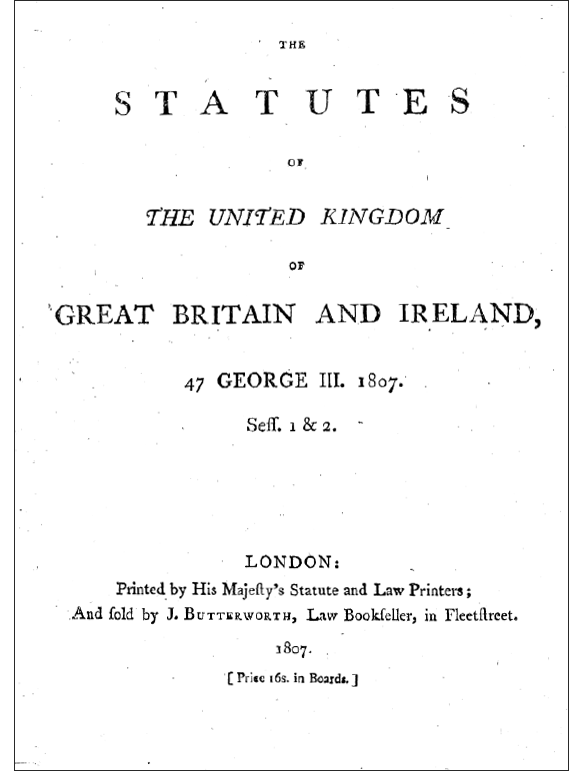Anti-Slavery Legislation in Global Perspective
|
"An Act for the Abolition of the Slave Trade," 25 March 1807. In The Statutes of the United Kingdom of Great Britain and Ireland (London: Butterworths, Fleet Street, 1807), 140-148. |
To facilitate research and teaching the global history of abolition, the Anti-Slavery Legislation Digital Archive contains hundreds of laws, decrees, treaties, and conventions from around the world from the eighteenth century up until the mid-twentieth century. The base of these materials derive from a sixteen volume collection of laws and treaties which archivists from the British Foreign Office compiled during the nineteenth century. These legal texts justified the capture of enslaved people and their "liberations" resulting in involuntary indentures or conscription. This glossary defines "Liberated Africans" in different languages and historical contexts.
Early precedents for the abolition of the slave trade began in the Atlantic world during the Age of Revolutions. This historical period is noted for often violent transitions from authoritative monarchies to representative governments, which enacted human rights laws and gradually abolished the slave trade. Denmark was the first European monarchy to do so by Royal Decree in 1792, but their law involved a ten-year grace period of open trade ending in 1803. By 1794, state legislatures in Pennsylvania prohibited the trade from the United States to any foreign place. By 1800, this law was amended and briefly enforced resulting in two early cases of enslaved people from Africa being removed from slave ships, "liberated," and involuntarily indentured by a state.
The increase of indentured or conscripted labor from Africa developed from the Britain's Act for the Abolition of the Slave Trade in 1807. Drafted during the Napoleonic Wars, this law legalized forfeitures of enslaved people as property removed from enemy slave ships. It also set out the terms for condemnation and liberation of people as property, which was followed by involuntary indentures or conscriptions. Also, the United States passed an Act Prohibiting the Importation of Slaves in 1807, but enforcement of this law was criminally lax (see als USAntiSlaveryLaws.org). Slave ships flying US flags continued to operate into the 1860s, delivering enslaved people elsewhere, especially to Cuba. Once the trans-Atlantic slave trade ended by 1867, suppression efforts focused on the Indian Ocean, Mediterranean, Red Sea, as well as inland Africa during colonization.
Following the Congress of Vienna in 1815, which brought peace to Europe after Napoleon’s defeat, British officials began drafting and signing treaties with other slave trading nations for preventing and abolishing the slave trade, most especially with Portugal (1817), Spain (1817), the Netherlands (1818), and Brazil (1826). The British incentivized the signing of anti-slavery treaties with dozens of monarchies and republics across Europe and in the Americas, even if those states were not heavily involved in the slave trade. Using gunboat diplomacy, the British also imposed several dozen anti-slavery treaties with kingdoms and peoples along the coast of West and East Africa, Madagascar, and the Arabian Peninsula.
|
"The Capture of the Slaver Gabriel by HMS Acorn, 6 July 1841." National Maritime Museum, Greenwich, London, Macpherson Collection, BHC0628, by Nicolas Matthew Condy, 1841. |
After British Emancipation in 1833, more anti-slavery treaties enabled the Royal Navy to search and seize slave ships in international waters and capture slave forts on the coast. Agreeing to such terms was a major diplomatic concession, considering Britain possessed the world's largest maritime power at the time. These treaties also led to the establishment of international courts of mixed commission, which were early international courts of humanitarian effort charged with the authority to adjudicate on cases involving the illegal slave trade. Only France, the United States, and Ottomans withheld granting the British the right of absolute search and seizure during most of the nineteenth century.
Over time, different monarchies and republics enacted their own anti-slavery legislation and implemented methods of suppressing the slave trade without British intervention. As a result, different strategies developed to emancipate and subject enslaved people to comparable indentures or conscriptions. After France's Second Abolition in 1848, this Law of 1853 allowed private companies and individuals to purchase and redeem enslaved people from slavery (rachat). After which, they were forced into contracts of indenture (engagé à temps). This purchase and indenture method was borrowed and adapted by the Dutch, Portuguese, Germans, and Arabs. After a Royal Decree in 1854, the Portuguese monarchy mandated that all masters must register their slaves living in its overseas colonies of Angola, Moçambique, and Cabo Verde.
In another vein, British, French, Austrian, and Italian consular and administrative offices provided refuge to people from Africa seeking asylum from slavery. In the Mediterranean world, enslaved people were handed over to Ottoman authorities who issued emancipation certificates under the Firman of 1857. Cases of asylum also occurred during the colonization of Africa, whereby enslaved people arrived to colonial offices, were "liberated" under international law, and entered into questionable labor contracts.
As the Atlantic slave trade ended, general emancipations became widespread among the largest slave-holding states in the Atlantic World. For example, the Netherlands passed Laws for the Abolition of Slavery in 1863, the XIII Amendment of the Constitution of the United States was enacted in 1865, while abolition in Cuba was in 1886, and Brazil in 1888. Among European nations, anti-slavery measures revolved around the Brussels Anti-Slavery Conference in 1890, which was a precursor to the League of Nations’ Slavery Convention in 1926 following World War I and the United Nations’ Universal Declaration of Human Rights in 1948 after World War II.
Student interns and research assistants at the Digital Slavery Research Lab at CU Boulder have helped build this digital archive. They are acknowledged for generating data and adding resources into the RegID content management system, which timestamps student contributions. For student names, internship programs, and years of involvement, please refer to the Project Team.

